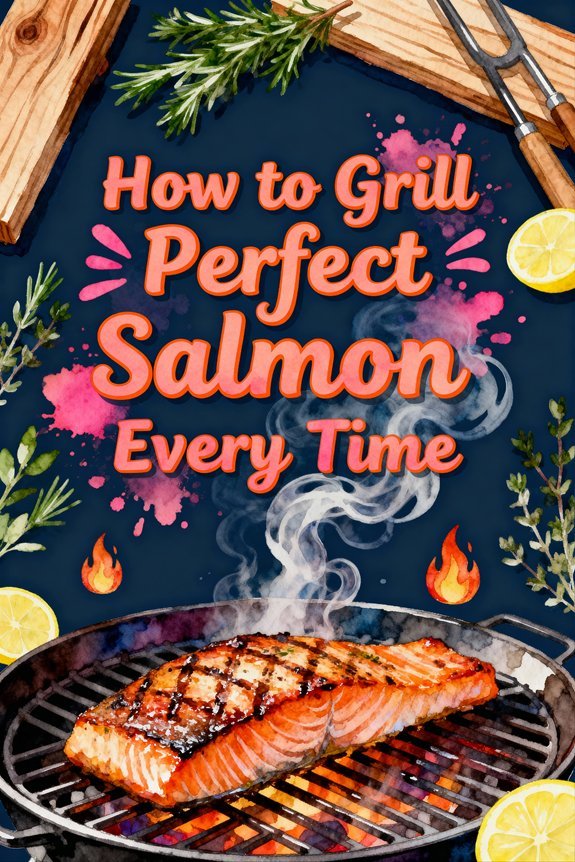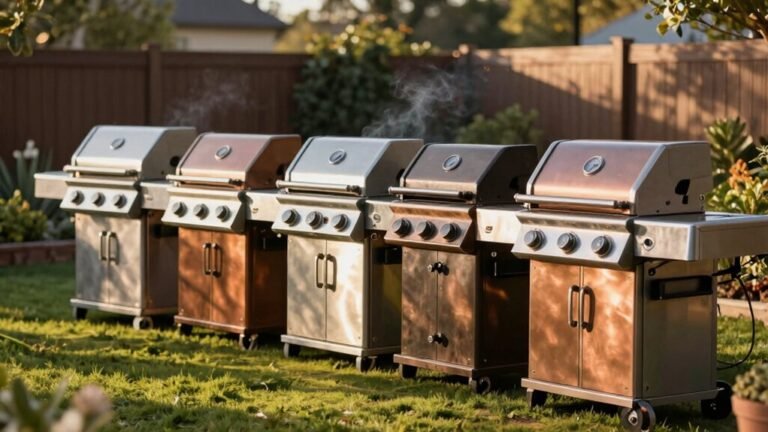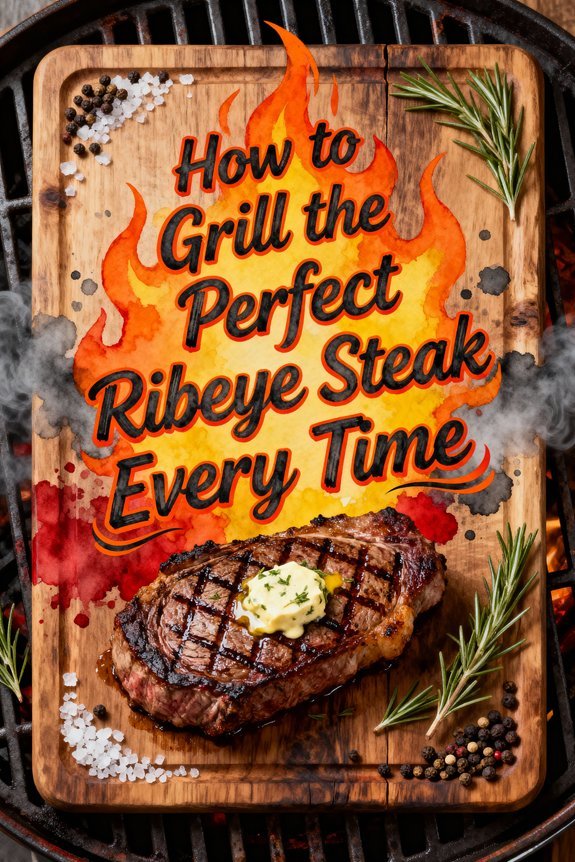For perfectly grilled salmon, start with a high-quality cut that’s 1-1.5 inches thick with skin on. Pat the fillet dry, then apply oil and seasonings. Preheat your grill to 450-500°F and guarantee clean, oiled grates. Grill skin-side down for 6-8 minutes until you see clear grill marks, then flip and cook for 2-4 minutes until internal temperature reaches 125-130°F. Let rest for 3-5 minutes. Master these fundamentals to elevate your salmon game.
Selecting the Best Salmon for Grilling
When it comes to grilling salmon, selecting the right variety can make the difference between a succulent meal and a disappointing dinner. Among salmon varieties, King (Chinook) stands out as your best choice due to its high fat content, which guarantees a buttery texture and superior moisture retention on the grill. Sockeye offers a robust flavor profile with enough fat to withstand high heat, while Coho provides a milder option for those preferring subtle tastes.
Look for cuts that are 1 to 1.5 inches thick with skin on, displaying firm, moist flesh and vibrant color characteristic of the variety. You’ll want bright red flesh for Sockeye or rich pink-orange for King salmon. Avoid pieces with brown spots or strong fishy odors, as these indicate diminished freshness. For optimal results, choose fillets that can reach internal temperature of 145°F within an hour of cooking.
Essential Preparation Steps
Before you fire up the grill, proper salmon preparation establishes the foundation for exceptional results. Start by cutting your salmon into uniform portions for consistent fillet sizing, then pat them completely dry with paper towels. Apply a thin coating of high-smoke-point oil and season generously with salt and pepper on all sides. High heat grilling requires temperatures between 450-550°F for optimal results. Similar to traditional smoking methods, using a meat thermometer helps ensure perfect doneness. Blackstone griddles offer exceptional temperature control for precise salmon cooking.
If you’re exploring marinating techniques, limit the process to 20 minutes in the refrigerator to enhance flavor without compromising texture. Your marinade should include an acidic component like citrus or vinegar, but remember to pat the fillets dry afterward. Keep the skin intact as it serves as a natural protective barrier during cooking. For ideal results, reserve a portion of your marinade before adding the fish if you plan to baste while grilling.
[affiai keyword=”salmon grilling prep tools and marinades” template=”carousel” count=”3″
Setting Up Your Grill for Success
Proper grill setup marks the difference between mediocre and restaurant-quality salmon. Start by positioning your grill in a well-ventilated area, away from any flammable materials. For ideal heat management, preheat your grill to 450°-500°F for gas or charcoal, or 325-350°F for pellet grills. Using all-natural hardwood briquettes will enhance the flavor profile of your grilled salmon.
Clean your grates thoroughly with a sturdy brush and apply oil using paper towels to create a non-stick surface. For optimal cleaning results, heat your grates to 400 degrees before scrubbing to help soften stubborn residue. Regular maintenance cleaning helps prevent carbonized grease buildup and ensures consistent cooking temperatures. If you’re using charcoal, employ a chimney starter to avoid chemical flavors. For precise temperature control, keep the lid closed and monitor your grill’s heat using a reliable thermometer.
Don’t forget to equip yourself with essential tools: a fish basket or flat grilling grate for easier handling, and a meat thermometer to verify your salmon reaches the safe internal temperature of 140°F.
[affiai keyword=”outdoor grill thermometer and cleaning tools” template=”carousel” count=”3″
Mastering the Grilling Technique
Successfully grilling salmon requires mastering fundamental techniques that deliver consistently excellent results. Position your center-cut fillets diagonally across the grates, spacing them at least one inch apart for ideal heat circulation. You’ll want to start with skin-side down grilling techniques at 450-500°F, letting the salmon cook undisturbed for 6-8 minutes until a proper crust forms. For optimal results, brush the grates with canola oil before placing the fish. Watch for opaque edges and clean grill marks before attempting your single flip. Similar to seared tuna steaks, monitoring cooking time carefully prevents overcooking the delicate fish. Using both spatula and tongs, carefully turn the fillet and cook for just 2-4 minutes on the flesh side. Different salmon types require subtle timing adjustments, but always remove the fish when it reaches 125-130°F internal temperature. Just like with tilapia, wait for the fish to naturally release from the grates before attempting to flip it. Let it rest 2-5 minutes before serving to guarantee perfect texture and moisture distribution.
Understanding Cooking Times and Temperature
Getting perfect salmon on the grill depends heavily on mastering precise temperatures and timing. For direct grilling, you’ll want to start at 450°F to achieve that initial sear, then reduce to 350-400°F after flipping. Different cooking methods require specific temperature control: direct grilling takes 6-8 minutes total, cedar plank grilling needs 10-15 minutes at 400°F, and foil-wrapped requires 14-18 minutes. Cedar planked salmon should be cooked with the lid closed for consistent temperature. Smoked salmon fillets can alternatively be cooked at lower temperatures between 225-275°F for a more tender result. Albumin prevention is crucial when cooking salmon, as excessive heat can cause this white protein to leak out and dry the fish.
Always aim for an internal temperature of 145°F for food safety, though you’ll find ideal results at 120°F for medium-rare. Remember to let your salmon rest for 5 minutes after cooking – this allows carryover cooking to complete and juices to redistribute. For consistent results, use an instant-read thermometer and follow the basic rule of 5-7 minutes per inch of thickness.
[affiai keyword=”digital meat thermometer for grilling” template=”carousel” count=”3″
Enhancing Flavors and Seasonings
Seasoning and flavoring salmon transforms it from a simple grilled fish into a memorable culinary experience. You’ll find success with store-bought spice blends containing paprika, dill, and garlic for smoky flavor profiles, or create your own marinade using soy sauce, olive oil, and honey for depth and caramelization. A quick 15-minute brine in saltwater helps the fish retain moisture and enhances seasoning absorption.
For ideal results, apply glazes during the final minutes of grilling. These protect against drying while creating an appealing crust. Consider teriyaki or sweet and spicy combinations for enhanced flavor development. Similar to using a cast iron skillet for indoor steak preparation, proper heat distribution is essential for even cooking and browning. Just like perfectly grilled burgers, using indirect heat helps maintain moisture and develop rich color. If you prefer natural seasonings, quality salt and pepper with wild lump charcoal deliver exceptional results.
Complete your dish with complementary sides like grilled asparagus or quinoa salad, and add aromatic additions such as chimichurri or dill yogurt sauce. These elements balance salmon’s richness while elevating your grilling technique.
[affiai keyword=”gourmet salmon seasoning and marinades” template=”carousel” count=”3″
Serving and Storing Your Grilled Salmon
Once you’ve achieved the perfect grilled salmon, proper serving and storage techniques will guarantee you maximize both its flavor and safety. Let your salmon rest for 3 minutes before presenting it with colorful herbs and lemon wedges. Using an instant-read thermometer will help ensure your salmon reaches the ideal temperature before serving. For ideal presentation techniques, pair your dish with white wines like Sauvignon Blanc and complement it with roasted vegetables or fresh salads. Consider making a Cajun cream sauce to elevate your grilled salmon to restaurant quality. Similar to grilled chicken, direct heat cooking produces the best results for even doneness and perfect sear marks.
For proper storage, refrigerate your salmon within two hours of cooking in airtight containers. When reheating methods are needed, use your oven or microwave to reach 145°F. Always maintain food safety by preventing cross-contamination between raw and cooked fish. Don’t let leftovers go to waste – transform them into creative dishes like salmon salads, patties, or pasta additions. For extended storage, properly wrapped salmon can be frozen for up to three months.
[affiai keyword=”airtight food storage containers for fish” template=”carousel” count=”3″










